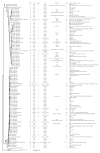Lineage, Antimicrobial Resistance and Virulence of Citrobacter spp
- PMID: 32155802
- PMCID: PMC7157202
- DOI: 10.3390/pathogens9030195
Lineage, Antimicrobial Resistance and Virulence of Citrobacter spp
Abstract
Citrobacter spp. are opportunistic human pathogens which can cause nosocomial infections, sporadic infections and outbreaks. In order to determine the genetic diversity, in vitro virulence properties and antimicrobial resistance profiles of Citrobacter spp., 128 Citrobacter isolates obtained from human diarrheal patients, foods and environment were assessed by multilocus sequence typing (MLST), antimicrobial susceptibility testing and adhesion and cytotoxicity testing to HEp-2 cells. The 128 Citrobacter isolates were typed into 123 sequence types (STs) of which 101 were novel STs, and these STs were divided into five lineages. Lineages I and II contained C. freundii isolates; Lineage III contained all C. braakii isolates, while Lineage IV and V contained C. youngae isolates. Lineages II and V contained more adhesive and cytotoxic isolates than Lineages I, III, and IV. Fifty-one of the 128 isolates were found to be multidrug-resistant (MDR, ≥3) and mainly distributed in Lineages I, II, and III. The prevalence of quinolone resistance varied with Lineage III (C. braakii) having the highest proportion of resistant isolates (52.6%), followed by Lineage I (C. freundii) with 23.7%. Seven qnrB variants, including two new alleles (qnrB93 and qnrB94) were found with Lineage I being the main reservoir. In summary, highly cytotoxic MDR isolates from diarrheal patients may increase the risk of severe disease.
Keywords: Citrobacter; adhesion; cytotoxicity; multidrug resistance; sequence types.
Conflict of interest statement
The authors declare no conflict of interest.
Figures







Similar articles
-
Antimicrobial Resistance and Cytotoxicity of Citrobacter spp. in Maanshan Anhui Province, China.Front Microbiol. 2017 Jul 20;8:1357. doi: 10.3389/fmicb.2017.01357. eCollection 2017. Front Microbiol. 2017. PMID: 28775715 Free PMC article.
-
Genetic Diversity, Multidrug Resistance, and Virulence of Citrobacter freundii From Diarrheal Patients and Healthy Individuals.Front Cell Infect Microbiol. 2018 Jul 10;8:233. doi: 10.3389/fcimb.2018.00233. eCollection 2018. Front Cell Infect Microbiol. 2018. PMID: 30050870 Free PMC article.
-
Antimicrobial Resistance and Molecular Characterization of Citrobacter spp. Causing Extraintestinal Infections.Front Cell Infect Microbiol. 2021 Aug 27;11:737636. doi: 10.3389/fcimb.2021.737636. eCollection 2021. Front Cell Infect Microbiol. 2021. PMID: 34513738 Free PMC article.
-
Listeria monocytogenes lineages: Genomics, evolution, ecology, and phenotypic characteristics.Int J Med Microbiol. 2011 Feb;301(2):79-96. doi: 10.1016/j.ijmm.2010.05.002. Epub 2010 Aug 13. Int J Med Microbiol. 2011. PMID: 20708964 Review.
-
A brief insight into Citrobacter species - a growing threat to public health.Front Antibiot. 2023 Dec 5;2:1276982. doi: 10.3389/frabi.2023.1276982. eCollection 2023. Front Antibiot. 2023. PMID: 39816660 Free PMC article. Review.
Cited by
-
Survey in ruminants from Rwanda revealed high diversity and prevalence of extended-spectrum cephalosporin-resistant Enterobacterales.BMC Vet Res. 2024 Nov 19;20(1):523. doi: 10.1186/s12917-024-04359-3. BMC Vet Res. 2024. PMID: 39563382 Free PMC article.
-
Characterization of cytotoxic Citrobacter braakii isolated from human stomach.FEBS Open Bio. 2024 Mar;14(3):487-497. doi: 10.1002/2211-5463.13770. Epub 2024 Jan 24. FEBS Open Bio. 2024. PMID: 38268325 Free PMC article.
-
KPC-3-, GES-5-, and VIM-1-Producing Enterobacterales Isolated from Urban Ponds.Int J Environ Res Public Health. 2022 May 11;19(10):5848. doi: 10.3390/ijerph19105848. Int J Environ Res Public Health. 2022. PMID: 35627386 Free PMC article.
-
Phenotypic and Genotypic Characteristics of Antimicrobial Resistance in Citrobacter freundii Isolated from Domestic Ducks (Anas platyrhynchos domesticus) in Bangladesh.Antibiotics (Basel). 2023 Apr 17;12(4):769. doi: 10.3390/antibiotics12040769. Antibiotics (Basel). 2023. PMID: 37107131 Free PMC article.
-
Detection and Antimicrobial Resistance of Enterobacteriaceae other than Escherichia Coli in Raccoons from the Madrid Region of Spain.J Vet Res. 2022 Nov 4;66(4):565-569. doi: 10.2478/jvetres-2022-0058. eCollection 2022 Dec. J Vet Res. 2022. PMID: 36846041 Free PMC article.
References
-
- Park Y.-J., Yu J.K., Lee S., Oh E.J., Woo G.-J. Prevalence and diversity of qnr alleles in AmpC-producing Enterobacter cloacae, Enterobacter aerogenes, Citrobacter freundii and Serratia marcescens: A multicentre study from Korea. J. Antimicrob. Chemother. 2007;60:868–871. doi: 10.1093/jac/dkm266. - DOI - PubMed
-
- Tschäpe H., Prager R., Streckel W., Fruth A., Tietze E., Böhme G. Verotoxinogenic Citrobacter freundii associated with severe gastroenteritis and cases of haemolytic uraemic syndrome in a nursery school: Green butter as the infection source. Epidemiol. Infect. 1995;114:441–450. doi: 10.1017/S0950268800052158. - DOI - PMC - PubMed
Grants and funding
LinkOut - more resources
Full Text Sources
Miscellaneous

